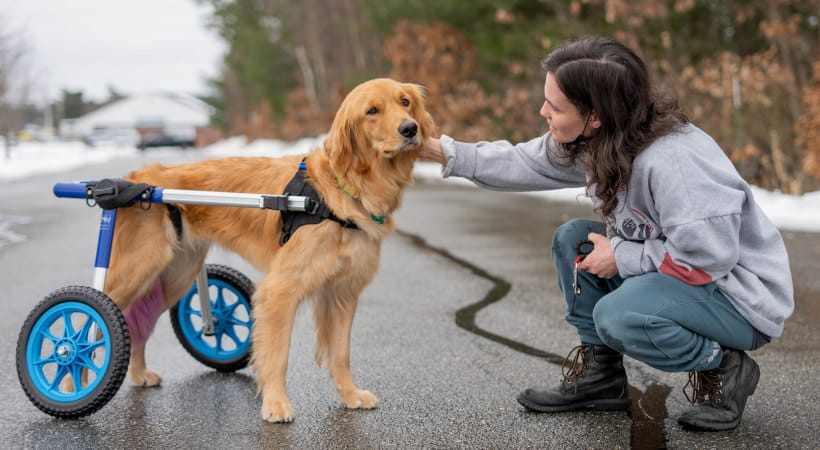Indicators Your Canine is Unwell
Canines are stoic, that means even after they aren’t feeling properly they act like they’re simply high-quality. It’s as much as pet mother and father to pay shut consideration and see these indicators that point out one thing could also be occurring.
Listed here are among the commonest indicators that your canine could also be feeling unwell:
Conduct Adjustments
Often your canine is tremendous excited, boinging up and down, to go in your morning stroll. However on this explicit morning, they wouldn’t even get away from bed. Perhaps your canine is laying in a really completely different spot than they usually do. Perhaps they present their enamel to the cat as a warning, which they’ve by no means executed earlier than. Like folks, when canines don’t really feel good, they don’t act like themselves.
Vomiting and Diarrhea
Vomiting or diarrhea might be attributable to a wide range of situations together with viral infections, parasites, or gastroenteritis. A canine will even vomit or have diarrhea if they’ve ingested one thing they shouldn’t have, akin to poisonous meals, crops or family chemical compounds akin to antifreeze. Minor bouts of vomiting and diarrhea with no different signs (drooling, listlessness) could right on their very own and never warrant a visit to the vet. But when the vomiting or diarrhea persists, or if you happen to see any blood, it’s best to search veterinary care instantly.
Fever
Like folks, canines usually have a fever when they’re combating some type of an infection or sickness. Indicators of a fever in a canine can embrace a heat dry nostril, heat ears, listlessness and maybe shivering or trembling.
After all this isn’t an exhaustive record of indicators your canine could also be coping with a well being drawback, however they’re the most typical. Now let’s check out the 31 commonest canine well being issues:
Frequent Canine Well being Issues
1. Arthritis
What’s arthritis?
As with folks, canines can undergo from arthritis as they age. Arthritis is the irritation of joints within the physique. A number of types of arthritis that have an effect on canines, and the most typical kind is osteoarthritis, a degenerative joint illness. Osteoarthritis occurs when the cartilage that protects the bones of a joint is destroyed. The joint loses any lubricating safety, which causes friction between bones and ends in vital ache.
Causes of arthritis
Normal arthritis is attributable to autoimmune problems, genetic joint instability, harm or trauma to ligaments, joint infections, or irregular cartilage progress. Osteoarthritis is a situation impacting older or aged canines as a consequence of ageing, hip or elbow dysplasia, weight problems, excessive exercise ranges, and metabolic ailments.
Signs of arthritis
The first signs of arthritis are lameness, stiffness, reluctance to stroll or climb up and down stairs, inactivity or sleeping extra, uncommon weight acquire, or lack of urge for food.
Remedy of arthritis
Your canine’s arthritis might be handled in a number of methods. A nutritious food plan, weight management, non-steroidal ache drugs, gentle train, therapeutic massage and acupuncture, and bodily rehabilitation (significantly water train) are all profitable means by which to handle arthritis in canines.
For extra sturdy data on the causes, signs, remedies, remedy prices and preventative measures for canine arthritis, be certain tor learn our full article known as Arthritis in Canines: Indicators, Causes & Therapies

2. Autoimmune Points
What are autoimmune points?
These points are frequent in folks and their pets. That’s why we put it autoimmune points in the beginning of this frequent canine well being issues record. There are a number of autoimmune ailments which might be frequent canine well being issues. Canine autoimmune ailments trigger a canine’s immune system to assault the physique’s tissues and cells versus defending them from exterior infections and sicknesses. There are a number of autoimmune problems that have an effect on canines, together with:
-
autoimmune pores and skin ailments
-
autoimmune hemolytic anemia
-
systemic lupus erythematosus
-
immune-mediated polyarthritis
-
immune-mediated thrombocytopenia (ITP)
Autoimmune points might be deadly to canines; due to this fact, your canine will want a veterinarian to carry out an correct prognosis and design a remedy plan.
For extra on the three high autoimmune ailments in canines, learn our article Autoimmune Ailments in Canines: Frequent points, Signs & Therapies
Causes of autoimmune points
Canine autoimmune problems and ailments have 4 major causes: genetics, vaccine reactions, sulfa antibiotic drugs, and disease-carrying ticks. It may be difficult to pinpoint an actual reason behind a canine’s autoimmune dysfunction, and veterinarians should analyze blood samples, genetic histories, in addition to carry out X-rays, MRIs, and ultrasounds to diagnose a canine with this situation.
Signs of autoimmune points
Though particular types of autoimmune ailments have explicit symptom associations, some signs seem in all kinds of canine autoimmune problems. These signs are probably the most generally present in canines with this medical situation:
-
Lameness
-
Ache in joints or muscle groups
-
Fever
-
Lethargy and weak spot
-
Anemia
-
Elevated thirst and urination
-
Weight reduction
-
Elevated respiratory and coronary heart charge
-
Enlarged lymph nodes
Remedy of autoimmune points
Autoimmune problems are handled from a number of angles. Corticosteroid immunosuppressive medication and topical ointments, surgical procedure, blood transfusions, and prednisone are conventional medical choices for treating these ailments. Various remedies embrace bodily remedy and hydrotherapy, acupuncture and therapeutic massage, dietary supplements, and dietary modifications to unprocessed meals with out preservatives, dyes, and chemical compounds.
3. Damaged Bones
What are damaged bones?
When a canine’s bone breaks, it ends in vital ache and discomfort. It’s comparatively straightforward for a canine to interrupt a bone. A canine’s back and front legs have three bones that may break in some ways for various causes. Listed here are the methods a canine can break a bone:
-
Hairline fractures, that are small cracks inside the bone
-
Damaged radius bones within the entrance leg (weight-bearing)
-
Damaged bones within the again legs (shin and thigh bones)
-
Dislocated bones, particularly within the shoulders and elbows
-
Open fractures (pores and skin breaks open and the damaged bone is uncovered)
-
Closed fractures (bone breaks however pores and skin stays intact)
Causes of damaged bones
Your canine can break a bone fairly immediately. Typically, a damaged bone happens when there may be some kind of impression or sudden drive to the canine’s legs or physique. For instance, your canine could have a fall or be struck by one thing massive, like a car. Smaller breeds could even break a leg by leaping up and down within the residence. Different causes of bone breaks are sports activities accidents, genetic well being points, poor food plan, insufficient calcium ranges, age, train or play, and ailments.
Signs of damaged bones
Damaged bones signs vary from apparent to refined. Apparent indicators of a damaged bone shall be any kind of open fracture accompanied by vital ache and bleeding. For closed fractures, a canine will favor one leg, limp, or refuse to stroll in any respect. Different signs are twisted legs, legs at irregular angles, bruising, swelling, and vocalizing (whining, howling, whimpering).
Remedy of damaged bones
Damaged bones must be stabilized as quick as potential to stop an infection and additional harm. A canine have to be rigorously transported to an animal hospital as inner accidents won’t be evident to the bare eye. The veterinarian will sedate the canine, order blood work and IV fluids, a catheter, and X-rays to find out the extent of the inner and exterior accidents.
Extreme breaks could require surgical procedure, whereas excessive circumstances could name for amputation of a limb. Minor breaks and fractures could also be positioned in a splint or forged.
4. Most cancers
What’s most cancers?
Sadly, most cancers is among the commonest canine well being issues. It’s the major reason behind demise in canines over 10 years previous and impacts 50% of senior canines. Most cancers causes the expansion of irregular cells that usually kind tumors or lots and will unfold to a number of organs. Kinds of most cancers in canines are as adopted:
-
Mouth and nostril most cancers
-
Melanoma
-
Testicular
-
Mind tumors
-
Osteosarcoma (bone most cancers)
-
Mast cell tumors
-
Hemangiosarcoma (blood vessel most cancers)
-
Lymphoma
-
Bladder most cancers
-
Squamous cell carcinomas (mouth and nail mattress most cancers)
-
Mammary carcinoma
-
Malignant histiocytosis (localized lesions)
Causes of canine most cancers
The causes of most cancers in canines are nonetheless beneath investigation. Sadly, scientists have but to seek out the connection between older canines and better most cancers charges. One concept is that ageing causes the canine immune system to weaken, making the cells extra vulnerable to mutation. Different possible causes embrace dietary, environmental, and hereditary elements.
Signs of most cancers
The indicators of most cancers could differ in canines relying on the kind of most cancers they’ve. Nonetheless, some signs that seem usually in most most cancers circumstances:
-
Proof of ache
-
Bumps and lumps beneath a canine’s pores and skin
-
Lack of urge for food
-
Irregular discharge from the ears, eyes, mouth, or rectum
-
Despair or lethargy
-
Adjustments in rest room behaviors
-
Sudden weight reduction
-
Stomach swelling
-
Problem respiratory or extreme coughing
Remedy for most cancers
Treating a canine’s most cancers relies upon the aggressiveness of the most cancers itself, as some cancers are extra harmful than others. Canines with most cancers ought to see a veterinary oncologist who can present particular remedy on your pup, significantly in diagnosing most cancers by means of ultrasound, biopsy, and urinalysis amongst different procedures. Different remedy therapies embrace chemotherapy, radiation remedy, surgical procedure, and immunotherapy.
For extra sturdy data on the causes, signs, remedies, remedy prices and preventative measures for canine most cancers, be certain tor learn our situation guides;
- Most cancers In Canines: Indicators, Sorts, Causes & Therapies
- Histiocytoma in Canines: Causes, Signs, Remedy & Prices
5. Canine Distemper
What’s canine distemper?
Canine distemper is a extremely contagious canine well being drawback that severely impacts your canines respiratory, gastrointestinal, and nervous techniques. This virus spreads by means of the air when contaminated canines cough or sneeze (nasal discharge), by means of shared meals and water bowls, and thru the bloodstream from mom canines to their puppies. Puppies youthful than 4 months previous and unvaccinated canines usually tend to purchase this illness.
Causes of canine distemper
The reason for this sickness is the distemper virus itself. Some locations the place the distemper virus could unfold rapidly are public parks, animal shelters, or in unregulated breeding operations and pet mills.
Signs of canine distemper
Canine distemper signs differ relying on the stage of the sickness. Listed here are the signs primarily based on virus development:
Early-stage signs, affecting the respiratory system
-
Fever
-
Sneezing
-
Coughing
-
Discharge from nostril and eyes
-
Pneumonia
Second stage signs, affecting the gastrointestinal system
-
Lack of urge for food
-
Diarrhea
-
Vomiting
Superior stage signs, impacting the nervous system
-
Stumbling
-
Despair
-
Seizures (from involuntary jaw snapping to grand mal)
-
Paralysis
Remedy of canine distemper
There isn’t any treatment for canine distemper virus; nonetheless, it may be prevented fully by having your canine vaccinated yearly to stay resistant to the virus.
For extra sturdy data on the causes, signs, remedies, remedy prices and preventative measures for canine distemper, be certain tor learn our situation information; Distemper in Canines: Causes, Signs & Therapies
6. Canine Influenza
What’s canine influenza?
Canine influenza virus (CIV) is among the commonest canine well being issues and one of the crucial contagious respiratory sicknesses in canines. First recognized in 2004 as an infectious illness in racing greyhounds in Florida, this type of flu unfold rapidly from contaminated canines to wholesome canines.
Causes of canine influenza
The causes of canine influenza are two Sort A viruses: H328 and H2N2. These viruses are of avian origin and differ from virus H3N2, which is the seasonal influenza virus. The canine influenza virus spreads by means of respiratory secretions akin to nasal discharge, coughing, and sneezing. As a result of the virus can stay for 12 hours on folks’s pores and skin, 24 hours on clothes, and 48 hours on surfaces, canines can even develop CIV if they arrive involved with contaminated collars and leashes, kennel partitions, meals and water bowls, and human clothes and pores and skin.
Signs of canine influenza
CIV signs are various, however most indicators seem in numerous elements of the respiratory system. The commonest CIV signs are:
-
Fever
-
Lethargy
-
Runny nostril
-
Coughing (dry or moist)
-
Sneezing
-
Lowered urge for food
-
Eye discharge
-
Respiratory difficulties
-
Pneumonia
It’s price noting that some canines have asymptomatic CIV the place they present no indicators of sickness.
Remedy for canine influenza
The remedy for CIV is supportive. Canines with CIV must be quarantined in a heat, dry location away from different canines. They want a top quality food plan and loads of water to let the virus run its course. Most canines get better from CIV inside a number of weeks; canines with extra extreme circumstances who develop pneumonia could require hospitalization, drugs, antibiotics, and intravenous fluids.
7. Canine Parvovirus
What’s canine parvovirus?
Canine parvovirus (CPV) is an especially contagious canine well being drawback that may impression the abdomen and small intestines (frequent circumstances) or the cardiovascular system (much less frequent). Most circumstances of parvovirus occur in puppies between six weeks and 6 months of age. It takes 3 – 10 days after publicity for a canine to point out signs of this sickness.
Causes of canine parvovirus
CPV is attributable to a genetic alteration of the unique canine parvovirus kind 2b. The virus damages intestinal cells, and in puppies, the center muscle. CPV spreads by means of direct contact with an contaminated canine or by means of direct or oblique contact with a canine’s feces. Merely sniffing contaminated feces or being uncovered to traces of CPV introduced into the home by sneakers which were involved with contaminated stool.
Signs of canine parvovirus
The sooner your pet’s signs are identified, the higher her possibilities of surviving a doubtlessly lethal illness. In puppies, the mortality charge from CPV is 91% in comparison with 10% in grownup canines. The signs of canine parvovirus are:
-
Lethargy
-
Anorexia
-
Extreme, bloody diarrhea
-
Vomiting
-
Fever
-
Normal ache and discomfort
Remedy for canine parvovirus
There isn’t any treatment for canine parvovirus. Supportive remedy is supplied by veterinarians who work to stop secondary infections, management diarrhea and vomiting, and changing fluids and electrolytes. Fecal transplants are a brand new CPV remedy process the place wholesome microbiomes exchange contaminated ones.
8. Periodontal Illness
What’s periodontal illness?
One other extremely frequent canine well being issues. Periodontal (dental) illness is a bacterial an infection of the mouth. It has 4 levels starting from the existence of plaque to extreme illness leading to tooth and bone loss. Practically 80% of canines have some type of dental illness by the age of two. Untreated dental illness can result in different canine well being points.
Causes of dental illness
Dental illness begins with the event of plaque on a canine’s enamel which causes gum illness and dangerous breath. Plaque progress results in gingivitis, accompanied by redness, swelling, and irritation of the gums. Left untreated, an an infection can set in and result in extreme ache, harm to tissue and gums, and tooth loss. Canines with periodontal illness usually tend to develop coronary heart illness and organ harm from micro organism continuously getting into the bloodstream and touring to the center.
Signs of dental illness
There are a number of indicators that will point out your canine has oral well being issues, and will have already got some dental illness. Search for these signs of dental illness in your canine:
-
Sore mouth
-
Bleeding gums
-
Rubbing or pawing on the mouth
-
Dribbling
-
Yellow or brown tartar on the enamel
-
Free enamel
-
Tooth loss
Remedy of dental illness
Remedy of periodontal illness begins with prevention. Annual oral exams by a veterinarian can forestall or catch dental illness in its earliest stage. Common cleanings, whereas the canine is beneath normal anesthesia, can right and reverse dental illness whether it is nonetheless in early levels. Brushing your canine’s enamel weekly and feeding your canine a specially-formulated, nutritious pet meals are different kinds of remedy for periodontal illness.
For extra sturdy data on the causes, signs, remedies, remedy prices and preventative measures for canine periodontal illness, be certain tor learn our situation information; Periodontal Illness in Canines: Signs, Causes, Remedy & Prevention
9. Diabetes
What’s diabetes?
Diabetes mellitus is a rising epidemic, particularly amongst older canines. This situation happens when a canine’s physique creates too little insulin, making it not possible for management of the sugar ranges within the bloodstream or has an irregular response to insulin. This metabolic illness can even impression a canine’s eyesight and have an effect on her total high quality of life.
Causes of diabetes
It’s not sure what causes diabetes in canines, though researchers consider that some canines are genetically predisposed. Weight problems additionally will increase a canine’s probability of growing diabetes.
Signs of diabetes
The indicators of diabetes are comparatively straightforward to determine. Listed here are the signs to search for if you happen to suspect your canine has this illness:
-
Extreme urination
-
Cataracts and cloudy eyes
-
Lackluster pores and skin and coat
-
Irregular thirst
-
Enhance in urge for food
-
Deteriorated imaginative and prescient
-
Sudden weight reduction (regardless of common consuming habits)
-
Urinary tract an infection
-
“Candy-smelling” breath
Remedy of diabetes
Whereas there isn’t a treatment for diabetes, it may be managed with cautious ongoing remedy in order that your canine can stay a full, completely happy life. Remedy includes these steps:
-
Common insulin photographs twice a day
-
A specifically designed diabetes-friendly food plan
-
Monitoring your canine for any modifications
-
Common visits to the veterinarian
10. Diarrhea
What’s diarrhea?
A standard canine well being drawback, diarrhea occurs when unabsorbed vitamins draw water or retain water within the intestines. Irregular and unfastened stools are the outcome, and typically they embrace blood or mucus. There are two sorts of diarrhea: acute (happens immediately) and persistent (occurs over weeks to months).
Causes of diarrhea
There are a number of causes of each acute and persistent diarrhea. Listed here are the causes of this situation:
-
Viral or bacterial an infection (acute and persistent)
-
Stress (acute and persistent)
-
Parasites (acute and persistent)
-
Dietary modifications or indiscretion (acute)
-
Medicines (acute and persistent)
-
Train intolerance (acute)
-
Metabolic ailments (acute and persistent)
-
Intestinal most cancers (persistent)
-
Ingestion of spoiled meals or overseas objects (acute)
-
Pancreatitis (persistent)
Signs of diarrhea
Diarrhea ranges from delicate to extreme, and extreme circumstances might be deadly. Indicators of diarrhea are as follows:
-
Free and watery stools
-
Weight reduction
-
Vomiting
-
Stomach ache
-
Weight reduction
Remedy of diarrhea
Diarrhea might be handled with a collection of steps. First, proceed to feed your canine in accordance with your veterinarian’s directions. Diet is a crucial step in letting your canine’s intestines start to heal. Subsequent, change your canine’s food plan by switching to a low fats, bland food plan with restricted elements. Feed a number of small meals to your canine throughout this time. Lastly, converse with a
veterinarian about probiotics and prebiotics to provide your canine to repopulate her intestine’s wholesome micro organism ranges.
For extra sturdy data on the causes, signs, remedies, remedy prices and preventative measures for canine diarrhea, be certain tor learn our situation information; Diarrhea in Canines: Causes, Remedy & Prevention
11. Ear Infections
What are ear infections?
Canine ear infections within the outer ear point out an irritation of the exterior ear canal. Infections can even happen within the internal or center ear. The an infection causes vital ache and discomfort, and in extreme conditions, lack of listening to. These are among the commonest canine well being issues seen by vets.
Causes of ear infections
Ear infections have many causes. Most ear infections being with micro organism and yeast trapped contained in the ear. Different causes of an infection embrace allergy symptoms to the setting or food plan, ear mites, wax buildup, or hypothyroid illness. Canines who’ve floppy ears or who’re vulnerable to allergy symptoms are on the highest threat of growing ear infections.
Signs of ear infections
Canines with ear infections are usually in ache and discomfort. These emotions usually manifest within the indicators of an infection, together with:
-
Offensive odor coming from the ears
-
Redness and irritation
-
Fixed scratching or pawing on the ears
-
Strolling in circles
-
Yellowish or brown discharge
-
Whining
-
Shaking and tilting the top
-
Lack of steadiness
-
Irregular eye actions
-
Lack of listening to
Remedy of ear infections
Veterinarians deal with canine ear infections with accredited drugs like gentamycin and tobramycin. In circumstances of extreme an infection, your canine may have sedation for a radical ear cleansing. Periodic cleanings with an ear cleaner might help forestall infections from growing in a canine’s ears.

12. Parasites
What are exterior parasites?
Exterior parasites, akin to ticks, mites, lice and fleas, are extra than simply irritations to a canine. They’re organisms that stay on a number and feed on that host. These parasites can carry ailments like dermatitis and anemia; they might additionally carry inner parasites like tapeworms as properly. Moreover, exterior parasites can set off allergy symptoms in canines.
Causes of exterior parasites
Parasites are attributable to a wholesome canine’s publicity to a canine or animal contaminated by exterior parasites or an setting the place the parasites exist.
Signs of exterior parasites
Apart from seeing parasites in your canine’s pores and skin and fur, there are different indicators of those organisms’ impact in your pup. Listed here are signs to search for:
-
Hair loss
-
Aggressive scratching
-
Scabs
-
Irritated and infected pores and skin
-
Extreme itching
Remedy of exterior parasites
Your veterinarian may give your canine medical remedy to eradicate the parasites. To stop additional an infection, canines ought to obtain preventative medication, obtain common testing throughout yearly exams, and their residing areas must be as clear as potential.
13. Fleas
What are fleas?
Fleas are six-legged wingless exterior parasites that stay on a canine’s pores and skin and feed off its blood. They’re roughly 1 1/sixteenth of an inch, brown in shade, with flattened our bodies. Fleas crawl and bounce from one host to a different. They’ve 4 progress levels: egg, larvae, pupae, and grownup.
Causes of fleas
Fleas are pure parasites that hop onto hosts to stay and feed. They switch themselves from an previous host to a brand new one by leaping or crawling, and so they could use the identical strategies to leap from the bottom or grass onto a number.
Signs of fleas
When a flea bites a canine, it leaves behind saliva that may trigger reactions in a canine. These indicators of flea infestation embrace:
-
Pores and skin rashes
-
Extreme scratching on the pores and skin
-
Sores and scabs
-
Hair loss
-
Pores and skin infections
Remedy of fleas
Utility of spot-on flea and tick remedy or a prescription for an oral flea preventative given by a veterinarian are two methods to fight this frequent canine well being issues.
14. Fungal Infections
What are fungal infections?
Fungal infections and ailments are extremely frequent in canines. Fungi are parasitic organisms that produce spores. When these spores enter a canine’s respiratory tract or pores and skin, an an infection can happen. Fungal infections can occur on the physique’s floor, or they are often systemic and unfold all through the inner physique techniques.
Causes of fungal infections
Fungal infections can have an effect on youthful, massive breed canines, canines with compromised immune techniques, and canines who’re taking cyclosporine. These infections are prompted when a canine inhales the fungal spores from the soil, ingests the spores, or if the spores enter an open wound.
Signs of fungal infections
Various kinds of fungal infections have particular signs related to them. Listed here are the most typical fungal infections and their signs:
-
Nasal aspergillosis: sneezing, nostril bleeds, nasal discharge, visibly swollen nostril, lack of urge for food
-
Blastomycosis: weight reduction, fever, eye irritation, pores and skin lesions, coughing, sudden blindness, seizures, lameness
-
Cryptococcosis: Lethargy, sneezing, raspy respiratory, lack of urge for food, weight reduction, sniffling, dizziness, eye issues
Remedy of fungal infections
One of the best probability of your canine overcoming a fungal an infection or illness is the administration of nasal or oral antifungal medication by a veterinarian.
15. Warmth Stroke
What’s warmth stroke?
Heatstroke (hypothermia) is the excessive elevation of a canine’s temperature not attributable to fever. Canines can’t launch warmth as simply as people can, and that makes them much more vulnerable to experiencing warmth stroke, which is why it is among the commonest canine well being issues. Hypothermia can occur rapidly, particularly in areas the place excessive temperatures are accompanied by excessive humidity or areas that aren’t properly ventilated, akin to a car. Heatstroke is a critical medical situation and might be deadly; there’s a 50% mortality charge for warmth stroke in canines.
Causes of heatstroke
There are two sorts of heatstroke: exertional and nonexertional. Exertional heatstroke occurs when a canine turns into overheated throughout train, often as a result of the canine has not had the prospect to acclimate her physique to the upper temperatures. A notable rise in temperatures causes nonexertional heatstroke whereas the canine is in an unventilated space with out entry to consuming water to remain cool.
Signs of heatstroke
Heatstroke signs occur quickly and require fast motion to chill a canine down and doubtlessly save her life. Be careful for these indicators of warmth stroke:
-
Accelerated coronary heart charge and pulse
-
Extreme panting
-
Dehydration
-
Darkish-colored or purple gums or tongue
-
Salivating and drooling
-
Diarrhea (could also be bloody)
-
Vomiting (could also be bloody)
-
Barking or whining in agitation
-
Glassy eyes
-
An elevated physique temperature of 40 °C (104 °F) or larger
-
Weak spot, staggering, or collapse
-
Seizures
-
Coma
Remedy for heatstroke
The remedy required for heatstroke includes an instantaneous journey to the emergency veterinarian. However there are steps you could take earlier than you get to the vet that may enhance your canine’s possibilities of survival:
-
provoke the cooling course of of their canine by shifting her to a shady spot and putting a cool, moist towel beneath her.
-
Provide your canine small quantities of water regularly if she is alert sufficient to drink.
-
Measure your canine’s temperature with a rectal thermometer, if potential.
-
Spray cool (not chilly) water over the canine’s physique if her temperature is excessive.
-
Cease spraying as soon as the canine’s temperature has dropped to 103.5 °F.
-
Dry her off with a dry blanket or towel.
-
Take her to the veterinarian.
The veterinarian will proceed the managed cooling course of, exchange your canine’s fluid and electrolyte ranges, and handle any secondary issues (clotting, organ failure, or inflammatory responses) that will happen.
16. Hookworms
What are hookworms?
Hookworms are inner parasites that stay in a canine’s digestive system. Their hook-like form permits them to connect to the liner of the intestinal wall to feed on a canine’s blood. Hookworms lay their eggs within the digestive tract and cross by means of to the setting by means of defecation. This parasite might be handed to unborn puppies by means of their mom’s milk. People are additionally vulnerable to hookworm infections.
Causes of hookworms
Hookworm larvae hatch as soon as they’ve been handed by means of feces and onto the soil. From there, they’ll infect a canine by means of contact or pores and skin penetration. Canines may even ingest hookworms when they’re licking themselves or swallowing grime.
Signs of hookworms
Hookworms may cause a wide range of signs in canines. These are the indicators most related to these parasites:
-
Diarrhea
-
Lack of urge for food
-
Weight reduction or failure to achieve weight
-
Pores and skin irritation (often between the toes)
-
Coughing (larval an infection within the lungs)
-
Tarry or bloody stools
-
Anemia (pale gums, weak spot)
Remedy of hookworms
Hookworms might be handled by administering treatment to finish the parasitic infestation. Your veterinarian can choose the correct treatment on your canine. Treatment solely impacts the hookworms contained in the gut; thus, remedy ought to repeatedly happen till all larvae have matured and died. The variety of remedies will rely in your canine’s age and extent of the infestation.
Pregnant canines will want explicit deworming protocols {that a} veterinarian can decide and supply to stop or cease hookworms from spreading to the unborn puppies.
17. Sizzling Spots (Acute Moist Dermatitis)
What are scorching spots?
Probably the most frequent canine well being issues – these superficial pores and skin problems in canines are scorching spots or acute moist dermatitis. These uncooked, purple, itchy and infected lesions usually seem immediately on a canine’s physique. Sizzling spots can turn into moist, oozing sores, particularly in case your canine regularly licks, gnaws, or bites at them; they’ll unfold quickly, and an infection could develop with out remedy.
Causes of scorching spots
Sizzling spots are attributable to something that irritates a canine’s pores and skin to the purpose the place she scratches, licks, or bites on the pores and skin repeatedly, inflicting a lesion to develop. Sizzling spots might be the results of a number of culprits, together with:
-
Moisture and humidity
-
Poor grooming
-
Allergic reactions
-
Pyoderma (pores and skin an infection attributable to yeast and micro organism)
-
Ear infections
-
Parasites and common pests (flies, mosquitoes)
-
Anal gland illness
-
Behavioral points (extreme licking to alleviate boredom or stress)
-
Contact irritants
-
Moisture trapped within the coat from bathing or swimming
Signs of scorching spots
Sizzling spots might be straightforward to determine when you’ve combed by means of your canine’s fur to seek out them. These are the indicators of scorching spots in your canine:
-
Redness
-
Hair loss
-
Swelling
-
Lesion is moist
-
Discharge of fluid or pus from the sore
-
Matted or crusted hair across the lesion
-
Your canine excessively licks, bites, or scratches at particular spots on her physique
Remedy of scorching spots
You’ll be able to deal with your canine’s scorching spots at residence if you happen to catch them early. Medicated anti-itch shampoos can kill micro organism and soothe infected pores and skin. This remedy ought to forestall scratching and let the pores and skin heal.
Veterinarian help is important for extreme scorching spot circumstances. A vet will clip away matted fur, apply a delicate antiseptic resolution to the injuries, and prescribe oral or topical steroids to lower itching and deal with secondary infections.
18. Kennel Cough
What’s kennel cough?
Kennel cough, or infectious tracheobronchitis, is a extremely contagious respiratory an infection the place a virus and micro organism have an effect on a canine’s windpipe, lungs, and voice field. Kennel cough is barely deadly to puppies, senior canines, and canines with compromised immune techniques. However it is among the commonest canine well being issues.
Causes of kennel cough
Kennel cough is attributable to the micro organism Bordetella bronchiseptica and canine parainfluenza virus. These pathogens mix to assault the cilia which line the lungs, inflaming the higher airway. This irritation causes canines to expertise a persistent, repetitive dry cough. Canines get kennel cough by respiratory within the air after an contaminated canine has coughed, sharing contaminated objects, or coming into contact with an contaminated canine.
Signs of kennel cough
Kennel cough can impression any canine unvaccinated in opposition to this an infection. Listed here are the signs of kennel cough in canines:
-
Persistent and unproductive dry cough
-
Deep honking cough
-
Sounds that appear like your canine is gagging or has one thing caught in her throat
-
Fever
-
Lethargy
-
Nasal discharge
-
Watery eyes
Remedy of kennel cough
Kennel cough remedy is dependent upon the severity of the an infection. Canines with delicate circumstances of kennel cough won’t obtain specialised remedy because the illness will run its course. Extreme circumstances of kennel cough require cough suppressants and oral antibiotics and must be resolved inside 7 – 14 days.
19. Leptospirosis
What’s leptospirosis?
Leptospirosis (“Lepto”) is a extremely contagious bacterial an infection which impacts canines and mammals together with rodents, wildlife, different canines, and people. Lepto exists world wide and is commonly present in moist, moist areas after rainfall.
Causes of leptospirosis
Lepto, which is among the commonest canine well being points, is attributable to a number of strains of the micro organism Leptospira spp. Canines can turn into contaminated by this micro organism in the event that they swim in or drink contaminated water, eat contaminated meat, or are available direct contact with one other contaminated animal.
Signs of leptospirosis
The indicators related to leptospirosis are sometimes non-specific and obscure. The next signs are linked to lepto and differ in depth:
-
Vomiting
-
Fever
-
Conjunctivitis
-
Despair and weak spot
-
Shivering
-
Coughing
-
Problem respiratory
-
Jaundice
-
Elevated urination
-
Muscle ache and stiffness
-
Lack of urge for food or anorexia
-
Liver or kidney failure
-
Elevated thirst
Some canines with lepto are asymptomatic and can present no indicators of getting the illness.
Remedy of leptospirosis
Canines with lepto are handled with antibiotics. For extreme circumstances, canines may have to hospitalization and look after any harm executed to the liver or kidney.
20. Weight problems
What’s weight problems?
We merely can’t depart weight problems off the record of frequent canine well being issues. Extreme weight, or weight problems, is a medical situation that’s frequent to many canines; between one-third and 40 % of canines are overweight or obese. Weight problems results in a number of well being issues for canines, particularly as they get older. Canines who’re overweight usually tend to develop most cancers, diabetes, coronary heart illness, and respiratory sicknesses, in addition to expertise a better total mortality charge.
Causes of weight problems
There are a number of the explanation why canines could turn into obese to the purpose of weight problems. Listed here are the most typical causes of weight problems:
-
Breed predisposition
-
Outdated age
-
Sure drugs that trigger weight acquire
-
Neutering
-
Endocrine ailments
-
Diet
-
Chubby or overweight house owners
Signs of weight problems
Indicators of weight problems embrace each signs that happen sooner and people who happen later:
-
Weight acquire
-
Lack of stamina
-
Incapability or unwillingness to train
-
Extra physique fats
-
Problem respiratory
-
Coronary heart illness
-
Respiratory sickness
-
Hypertension
-
Diabetes
-
Hypothyroidism
-
Most cancers
-
Shortened life span
Remedy of weight problems
Weight problems is a reversible situation. Remedy consists of switching your canine to a lightweight pet food beneath your veterinarian’s supervision in addition to feeding your canine on a strict schedule. Cease feeding treats, snacks, and desk meals to your canine. Your canine will start to shed weight with gentle to average train and play within the yard or at an area canine park.

21. Prostate Issues
What are prostate issues?
The prostate is a gland of the reproductive system, and male canines are inclined to varied points with it. The first kinds of prostate issues are prostate enlargement, bacterial an infection, cysts, and most cancers.
Causes of prostate issues
These are the causes of the primary kinds of prostate points:
-
Prostate enlargement is attributable to the enlargement of the prostate gland in each lobes.
-
Bacterial infections happen when micro organism enter the physique by means of the prostate by way of blood or urinary tract.
-
Cysts develop adjoining to the prostate after beginning and slowly enhance in dimension to place strain on the prostate, urethra, rectum, and colon.
-
Most cancers develops within the prostate and spreads rapidly to different organs within the physique. Prostate most cancers in canines is uncommon.
Signs of prostate issues
The indicators of prostate issues are linked to the kind of prostate sickness your canine suffers from, however there are common signs that every one 4 varieties share:
-
Straining whereas urinating or defecating
-
Constipation
-
Blood in urine
-
Bloody or yellow discharge from the penis
-
Lack of urge for food
-
Lethargy
-
Fever
-
Stomach ache
-
Rectal ache
-
Weight reduction
-
Problem respiratory (most cancers)
-
Ribbon-shaped stool (most cancers)
Remedy of prostate issues
For prostate enlargement, there isn’t a particular remedy; nonetheless, if the enlarged prostate makes the canine’s high quality of life uncomfortable, it’s possible you’ll have to have your canine neutered.
Bacterial prostate infections are handled with hospitalization and antibiotics by way of IV; in some circumstances, surgical procedure could also be crucial. You’ll be able to eradicate your canine’s cysts by having him castrated. There isn’t any treatment for prostate most cancers, and remedy is proscribed to radiation and medical remedy for short-term hospice care.
22. Rabies
What’s rabies?
Rabies is a viral illness that causes mind irritation and impacts the central nervous system, and sadly, it is among the commonest canine well being points. As soon as the signs of rabies seem, fatality will quickly comply with; thus, canines with rabies are euthanized.
Causes of rabies
Rabies spreads by means of contact with the saliva of an contaminated animal; the wildlife most definitely to hold rabies are raccoons, skunks, foxes, and bats. The an infection spreads from a chunk wound, however it might additionally unfold by means of an open wound or scratch.
Signs of rabies
Though the incubation interval for rabies varies by case, usually inside 3 to eight weeks, these signs will seem:
-
Fever
-
Pica
-
Aggressiveness
-
Nervousness
-
Seizures
-
Dropped jaw
-
Hydrophobia
-
Paralysis
-
Respiratory failure
Remedy of rabies
There isn’t any treatment or remedy for rabies. You’ll be able to forestall your canine from contracting rabies by getting her vaccinated in opposition to this illness.
23. Ringworm
What’s ringworm?
Ringworm is a fungus that produces infective spores that stay off the useless hair and pores and skin tissues on a canine. These spores then infect damaged pores and skin, inflicting hair loss in spherical patchy lesions. Ringworm most regularly impacts younger canines, long-haired canines, and aged canines.
Causes of ringworm
A group of pathogenic fungi causes ringworm. These fungi develop on the floor of the pores and skin, within the hair follicles, and typically within the canine’s nails.
Signs of ringworm
Though not life-threatening, ringworm is contagious and will require remedy from a veterinarian. These are the indicators related to ringworm in canines:
-
Dry, brittle hair
-
Infected pores and skin
-
Scabby pores and skin
-
Dandruff-like scaling within the coat
-
Pink lesions and hair loss (head, chest, forelegs, again ridge)
-
Brittle, tough nails
Remedy of ringworm
Your canine’s veterinarian will administer oral treatment to do away with the ringworm. In extreme circumstances, you may additionally want to make use of a topical medicated shampoo or lotion on the pores and skin.
24. Roundworms
What are roundworms?
Roundworms (ascarids) are the most typical parasite in canines. The canine roundworm species are Toxocara canis and Toxocara leonine. Roundworms stay within the abdomen and intestines; they’ll develop to 7-inches lengthy and lay upwards of 20,000 eggs a day.
Causes of roundworms
Roundworms are extremely contagious parasites. They unfold when an contaminated canine sheds roundworm eggs in her feces. This illness can even switch when different canines sniff or lick on the contaminated stool. Moreover, roundworm eggs unfold by means of contact with birds, rodents, earthworms, and cockroaches.
Roundworm eggs can switch from the placenta to an unborn pet. Nursing from contaminated mom’s milk is one other means puppies get ringworm.
Signs of roundworms
Some canines with ringworm infections are asymptomatic and don’t present any indicators of sickness. Most canines with ringworm will exhibit the next signs:
-
Weight reduction
-
Vomiting
-
Uninteresting hair
-
Diarrhea
-
Coughing
-
Potbellied look
Remedy of roundworms
Roundworms in puppies are handled with a number of rounds of deworming. Preventative measures contain putting your canine on heartworm treatment.
25. Pores and skin Allergic reactions
What are pores and skin allergy symptoms?
Discuss frequent canine well being issues! Pores and skin allergy symptoms are a traditional, frequent well being situation that many canines wrestle with every day. Many canines have delicate pores and skin or are vulnerable to sure elements of their setting. Allergy sources might be tough to determine, however there are a number of how to deal with allergy symptoms and provides your canine some reduction.
Causes of pores and skin allergy symptoms
Pores and skin allergy symptoms might be attributable to absolutely anything and every little thing in canines. Listed here are the most typical allergy symptoms present in canines:
-
Contact and inhalant allergy symptoms (pollen, grasses, mud mites, molds)
-
Flea allergy symptoms
-
Meals allergy symptoms
-
Bacterial hypersensitivity
-
Treatment
-
Dander
-
Seborrhea (dandruff)
Signs of pores and skin allergy symptoms
The indicators of pores and skin allergy symptoms can turn into noticeable fairly rapidly, particularly as a consequence of your canine’s apparent discomfort. Search for these signs of allergy symptoms in your pup:
-
Itchy ears
-
Hives
-
Extreme itching and scratching
-
Infected pores and skin
-
Altered conduct
-
Vomiting
-
Diarrhea
-
Sneezing
Remedy of pores and skin allergy symptoms
There may be a variety of remedies for allergy symptoms, relying on their severity:
-
Weekly medicated baths (calm allergic irritation and soothe pores and skin)
-
Dietary supplements (Omega-3 and Omega-6 important fatty acids)
-
Antihistamines
-
Antifungal drugs
-
Hypoallergenic diets
-
Antibiotics
-
Flea management remedies
-
Immunotherapy (allergy photographs)
-
Environmental management
-
Corticosteroids
-
Thyroid treatment
26. Tapeworms
What are tapeworms?
The tapeworm is a flat, white, segmented parasite generally present in canines. Tapeworms stay inside a canine’s intestinal tract, rising from 4 to twenty-eight inches in size. They latch onto the within partitions of the abdomen and feed from there.
Causes of tapeworms
When a canine ingests a number of tapeworm eggs, akin to an grownup flea, a tapeworm an infection can happen. This example could occur when the canine is self-grooming, or if the canine licks or bites an contaminated animal, akin to a rabbit, rodent, or fowl.
Signs of tapeworms
Tapeworm signs embrace any of the next elements:
-
A canine scooting her learn finish on the bottom
-
Lethargy
-
Prolonged stomach
-
Uninteresting coat
-
Weight reduction (even with a daily food plan)
-
Vomiting
-
Diarrhea
-
Seen proof of tapeworms
Remedy of tapeworms
The remedy of tapeworms embrace deworming procedures that are confirmed efficient for eliminating the infestation.
27. Tick-Borne Ailments
What are tick-borne ailments?
Rocky Mountain noticed fever, anaplasmosis, and ehrlichiosis are three tick-borne ailments which might be growing in prevalence. Ticks are parasites that latch onto canines and feed on their blood. By doing so, ticks immediately transmit ailments right into a canine’s physique. The outcomes vary from delicate irritation to full-blown ailments.
Causes of tick-borne ailments
Tick-borne ailments are attributable to the tick’s transmission of illness immediately into canine techniques. Sure ticks trigger particular ailments to happen; there are seven various kinds of tick-borne ailments that canines are vulnerable to contracting.
Signs of tick-borne ailments
Though every tick-borne illness has its attribute acute signs, all of those ailments have related flu-like indicators in the beginning of the illness:
-
Lack of urge for food
-
Fever
-
Swollen lymph nodes
-
Lethargy
-
Vomiting
-
Stiffness in joints
-
Diarrhea
Remedy of tick-borne ailments
The principle remedy for tick-borne sicknesses is to manage a broad-spectrum antibiotic; the sooner the illness is discovered and handled, the higher the prognosis. Oral or topical tick prevention merchandise, plus annual screenings might help your canine keep away from tick-borne ailments altogether.
28. Toxicity or Poisoning
What’s toxicity/poisoning?
Toxicity and poisoning happen when your canine ingests some merchandise or materials that’s poisonous or toxic to her physique.
Causes of toxicity/poisoning
Poisoning and toxicity are sometimes the outcomes of your canine gaining access to substances or objects that she will eat, drink, and swallow.
Signs of toxicity/poisoning
The signs of toxicity and poisoning are sometimes depending on the toxin your canine has ingested. Listed here are some indicators of poisoning related to most poisonous objects:
-
Drooling
-
Vomiting
-
Lack of urge for food
-
Rashes on the contact web site
-
Labored respiratory
-
Seizures and tremors
-
Lack of consciousness
-
Organ failure
-
Sensitivity to gentle
-
Lack of coordination
-
Coma
-
Loss of life
Remedy of toxicity/poisoning
In case you suspect your canine is poisoned, contact the Pet Poison Management Hotline for help. Wrap your canine in a blanket and transport her to the veterinarian instantly if she is convulsing or seizing. Induce vomiting in your canine if she has not already thrown up and if the poison is just not petroleum or caustic substance. One of the best type of remedy is to get your canine to an emergency veterinary clinic as rapidly as potential.
29. Urinary Tract Infections
What are urinary tract infections?
Urinary tract infections (UTIs) are frequent bacterial infections that contain the urinary tract and bladder. Any breed of canine can develop a urinary tract an infection.
Causes of urinary tract infections
UTIs happen when micro organism works its means into the urethra, usually from contact with particles or feces in that space. Canines with weakened immune techniques are additionally weak to this an infection. E. Coli is the micro organism most answerable for urinary tract infections.
Signs of urinary tract infections
The signs of UTIs are comparatively straightforward to note. Hold an eye fixed out for these indicators of UTI in your canine:
-
Dribbling urine
-
Licking at or across the urinary opening
-
Cloudy and/or bloody urine
-
Fever
-
Needing to go exterior to urinate extra regularly than regular
-
Straining or whimpering throughout urination
-
Elevated water consumption
Remedy of urinary tract infections
Urinary tract infections are handled after a veterinarian has run a urinalysis in your canine. After the vet verifies the UTI, your canine shall be on an 8 to 10-day spherical of antibiotics. You have to to extend your canine’s water consumption throughout remedy to assist flush out remaining micro organism.
30. Vomiting
What’s vomiting?
Vomiting belongs beneath the umbrella of frequent canine well being issues and infrequently, it isn’t trigger for alarm. In case your canine vomits with out every other signs, she most likely simply had an upset abdomen. Nonetheless, in case your canine vomits accompanied by different signs, then her conduct is trigger for concern.
Causes of vomiting
Acute vomiting (extreme or sudden vomiting) might be attributable to a wide range of substances, sicknesses, and ailments. Listed here are among the frequent causes of acute vomiting:
-
Ingesting poisonous or irritating substances (chocolate, spoiled meat)
-
Heatstroke
-
Response to a drugs
-
Food plan change
-
Liver failure
-
Poisoning
-
Bacterial an infection
-
Bloat
-
Viral an infection
-
Pancreatitis
Continual vomiting (long-term, frequent vomiting) is a critical scenario and will the results of these elements:
-
Parvovirus
-
Intestinal irritation
-
Constipation
-
Uterine an infection
-
Intestinal obstruction
-
Most cancers
-
Liver illness
-
Kidney or liver failure
-
Pancreatitis
-
Colitis
-
Pancreatitis
Signs of vomiting
Critical circumstances of vomiting are evident alongside any of the next signs:
-
Vomiting massive quantities at one time
-
Vomiting blood
-
Dry vomiting
-
Steady vomiting
-
Continual vomiting
-
Vomiting with weight reduction, lethargy, and/or fever
-
Bloody diarrhea
-
Seizures
-
International physique ingestion
Remedy of vomiting
Remedy of acute or persistent vomiting begins along with your veterinarian who will run a collection of diagnostic exams, blood work, X-rays, and fecal evaluation to find out the underlying reason behind the vomiting. Usually of vomiting, remedy will embrace anti-nausea treatment and a bland food plan. For extra extreme circumstances, hospitalization, fluid therapies and surgical procedure could also be crucial.
31. Whipworms
What are whipworms?
Whipworms are frequent intestinal parasites in canines which unfold when contaminated canines cross whipworm eggs by means of their feces. They’re additionally one of the crucial frequent canine well being issues. Whipworms, named for his or her whip-like form, usually lay eggs which hatch and mature within the intestinal tract. These parasites can stay in your canine’s intestinal system for as much as 5 years.
Causes of whipworms
Your canine can develop a whipworm an infection by ingesting whipworm eggs from soil or different substances that include traces of stool. Canines who spend time in a contaminated space, akin to canine parks or backyards, may turn into uncovered to those parasites.
Signs of whipworms
Not all canines with whipworm infections will present indicators of the parasites. These canines who do present signs will probably have a number of of the next behaviors:
-
Weight reduction
-
Bloody stools
-
Dehydration
-
Diarrhea
-
Recurring weak spot
-
Frequent makes an attempt to defecate
-
Straining to defecate
-
Urgency to defecate
Remedy of whipworms
Whipworms are one of the crucial frequent canine well being issues and so they shouldn’t be ignored. Your veterinarian will give your canine prescription parasite drugs. You’ll be able to forestall future whipworm infections by putting your canine on a parasite preventative treatment every month; moreover, many month-to-month heartworm drugs additionally embrace preventatives in opposition to whipworms.
Pet Well being Insurance coverage Can Assist Pay for These Frequent Canine Well being Issues
It’s by no means enjoyable when our pups are coping with one of many many frequent canine well being issues we’ve simply listed. And it could possibly value an absolute fortune attempting to get them properly.
Pet medical health insurance helps pet mother and father take the easiest care of their fur infants by serving to to pay a part of the vet invoice. Plans begin as little as $10 a month and a few will reimburse for as much as 90% of the vet invoice.
Don’t let the frequent canine well being issues preserve you up at night time. Take 2 minutes to get a custom-made quote immediately.
References
-
Anderson, Okay. (2019). Cataracts in Canines: Levels, Causes, Therapies, and Extra. Retrieved from https://www.certapet.com/cataracts-in-dogs/
-
Racine, E. (2019). Osteoarthritis in Canines — Indicators and Remedy. Retrieved from https://www.akc.org/expert-advice/well being/osteoarthritis-signs-treatment/
-
Banfield Pet Hospital. (n.d.). What Causes Arthritis in Canines? Retrieved from https://www.banfield.com/pet-healthcare/additional-resources/article-library/conditions-illnesses/arthritis-in-dogs
-
Clark, M. (2019). Autoimmune Illness in Canines: Sorts, Signs, and Therapies. Retrieved from https://dogtime.com/dog-health/52995-autoimmune-disease-dogs-types-symptoms-treatments
-
Moore, A. (2018). Autoimmune Illness in Canines — 4 Essential Causes and Remedy Plans. Retrieved from https://www.dogster.com/dog-health-care/autoimmune-disease-in-dogs
-
Canna-Pet. (2018). Indicators & Signs of a Damaged Leg in Canines. Retrieved from https://canna-pet.com/signs-symptoms-of-a-broken-leg-in-dogs/
-
Breeding Enterprise. (2020). 20 Most Frequent Canine Ailments w/Explanations & Signs. Retrieved from https://breedingbusiness.com/common-dog-diseases/#18-autoimmune-issues
-
Manuals Employees. (2020). Causes of Most cancers. Retrieved from https://www.merckvetmanual.com/special-pet-topics/cancer-and-tumors/causes-of-cancer
-
The Drake Middle. (2020). Canine Most cancers — Signs, Prognosis & Remedy. Retrieved from https://www.merckvetmanual.com/special-pet-topics/cancer-and-tumors/causes-of-cancer
-
OncoLink Staff. (2019). 10 Steps To Take When Your Pet Had Most cancers. Retrieved from https://www.oncolink.org/cancers/vet/10-steps-to-take-when-your-pet-has-cancer
-
American Veterinary Medical Affiliation. (2020). Canine distemper. Retrieved from https://www.avma.org/assets/pet-owners/petcare/canine-distemper
-
Cornell College School of Veterinary Medication. (2016). Canine influenza virus. Retrieved from https://www.vet.cornell.edu/animal-health-diagnostic-center/veterinary-support/disease-information/canine-influenza-virus
-
Ward, E., Panning, A. (2017. Canine Influenza: The Canine Flu. Retrieved from https://www.vet.cornell.edu/animal-health-diagnostic-center/veterinary-support/disease-information/canine-influenza-virus
-
Facilities for Illness Management and Prevention. (2018). Key Info about Canine Influenza (Canine Flu). Retrieved from https://www.cdc.gov/flu/different/canine-flu/keyfacts.html
-
Butler, J. (2018). Parvo in Canines: Warning Indicators and Prevention of Parvovirus. Retrieved from https://www.caninejournal.com/parvo-in-dogs/
-
PetMD. (2020). Canine Parvovirus in Canines: Causes, Signs & Extra. Retrieved from https://www.petmd.com/canine/situations/infectious-parasitic/c_dg_canine_parvovirus_infection
-
Shaw Becker, Okay. (2018). New Remedy Slashes Parvo Mortality Charge and Restoration Instances. Retrieved from https://healthypets.mercola.com/websites/healthypets/archive/2018/07/27/fmt-helping-dogs-survive-parvo.aspx
-
Hill’s Pet. (2019). Dental Illness in Canines: Signs & Remedy. Retrieved from https://www.hillspet.com/dog-care/healthcare/dental-disease-in-dogs
-
Banfield Pet Hospital. (n.d.). Canine Dental Illness. Retrieved from https://www.banfield.com/pet-healthcare/additional-resources/article-library/dental/canine-dental-disease
-
Purina. (n.d.). Diabetes in Canines. Retrieved from https://www.purina.co.uk/canines/health-and-nutrition/dogs-with-special-needs/diabetes-in-dogs
-
Diamond Pet Meals. (2020). When Ought to You Fear About Doggy Diarrhea? Retrieved from https://www.diamondpet.com/weblog/well being/sensitive-stomach/when-should-worry-doggy-diarrhea/
-
Scott, D. (2020). How To Cease Diarrhea in Canines: 4 Easy Steps. Retrieved from https://www.dogsnaturallymagazine.com/stop-dog-diarrhea/
-
Shojai, A. (2019). Ear Infections in Canines. Retrieved from https://www.thesprucepets.com/puppy-ear-infection-2804952
-
Hyperlinks Veterinary Group. (2019) Fleas, Ticks, Mites, Lice — Exterior Parasites. Retrieved from https://www.linksvet.co.uk/recommendation/141-fleas-ticks-mites-lice-external-parasites
-
Feinn, L. (2018). How To Get Rid Of Fleas On Your Canine And In Your Home. Retrieved from https://www.thedodo.com/close-to-home/get-rid-of-fleas-on-dogs
-
College of Missouri Veterinary Well being Middle. (2017). Fungal Illness. Retreived from http://vhc.missouri.edu/small-animal-hospital/small-animal-internal-medicine/diseases-and-treatments/fungal-disease/
-
T., V. (2020). Canine Warmth Stroke. Retrieved from https://www.iowaveterinaryspecialties.com/student-scholars/canine-heat-stroke-literature-review
-
Lengyel, Okay. (2018). The three-Tiered Method to Treating Heatstroke in Canines. Retrieved from https://www.americanveterinarian.com/information/the-3tiered-approach-of-treating-heatstroke-in-dogs
-
Playforth, L. (2018). Warmth Stroke in Canines. Retrieved from https://www.vets-now.com/pet-care-advice/heatstroke-in-dogs/
-
Thomas Labs. (2020). What Causes Sizzling Spots on Canines? Retrieved from https://www.thomaslabs.com/product/what-causes-hot-spots-on-dogs/dog-articles
-
Cox, S. (2019). Dwelling Therapies for Moist Dermatitis in Canines — Sizzling Spots. Retrieved from https://thebark.com/content material/home-treatments-moist-dermatitis-dogs-hot-spots
-
PetAirapy. (2018). Kennel Cough in Canines — Transmission, Signs, Prevention, Remedy. Retrieved from https://petairapy.com/canine-cough-kennel-cough-in-dogs/
-
Paul, M. (2015). Lethal Leptospirosis in Canines: What You Have to Know to Shield Your Canine. Retrieved from http://www.pethealthnetwork.com/dog-health/dog-diseases-conditions-a-z/deadly-leptospirosis-dogs-what-you-need-know-protect-your-dog
-
Stenton, D. (2018). What to Know About Canine Weight problems. Retrieved from https://www.handicappedpets.com/weblog/need-to-know-about-dog-obesity/
-
Wag Strolling. (2020). Prostate Enlargement in Canines. Retrieved from https://wagwalking.com/situation/prostate-enlargement
-
Cesar’s Approach. (2018) What You Want To Know About The Canine Prostate. Retrieved from https://www.cesarsway.com/what-you-need-to-know-about-the-dog-prostate/
-
American Humane. (2016). Rabies Info & Prevention Ideas. Retrieved from https://www.americanhumane.org/fact-sheet/rabies-facts-prevention-tips/
-
Blue Cross for Pets. (2019). Ringworm in canines. Retrieved from https://www.bluecross.org.uk/pet-advice/ringworm-dogs
-
Inside Out Canine Coaching (2016). Roundworms in Canines. Retrieved from https://insideoutdogtraining.com/roundworms-in-dogs/
-
American Medical Middle of Southern California. (2020). Canine Allergic Dermatitis: Causes and Remedy Choices. Retrieved from https://animalmedcenter.com/canine-allergic-dermatitis/
-
Lambert Vets Provide. (2018). Assist! My Canine Has Tapeworms! Retrieved from https://www.lambertvetsupply.com/wellpetpost-help-my-dog-has-tapeworms.html
-
AKC Canine Well being Basis. (2018). Canine Tick-Borne Illness. Retrieved from http://www.akcchf.org/canine-health/your-dogs-health/caring-for-your-dog/canine-tick-borne-disease.html
-
Drake, A. (n.d.). Signs of Canine Poisoning. Retrieved from https://canines.lovetoknow.com/wiki/Symptoms_of_Dog_Poisoning
-
Pet Poison Hotline. (2020). Pet Poison Hotline. Retrieved from https://www.petpoisonhelpline.com
-
OVRS Employees. (2015). When You Gotta Go: Urinary Tract An infection in Canines. Retrieved from https://www.ovrs.com/weblog/when-you-gotta-go-urinary-tract-infection-in-dogs/
-
NomNomNow. (2018). Canine Vomiting Causes and Remedy. Retrieved from https://www.nomnomnow.com/be taught/food-transition-vomiting/dog-vomiting-causes-and-treatment
-
BluePearl Pet Hospital. (2018) Canine Vomiting: When Ought to You Be Involved? Retrieved from https://bluepearlvet.com/pet-blog/dog-vomiting-when-should-you-be-concerned/
-
PetBasics. (2017) Whipworms in Canines. Retrieved from https://www.petbasics.com/dog-education/whipworms-in-dogs/













